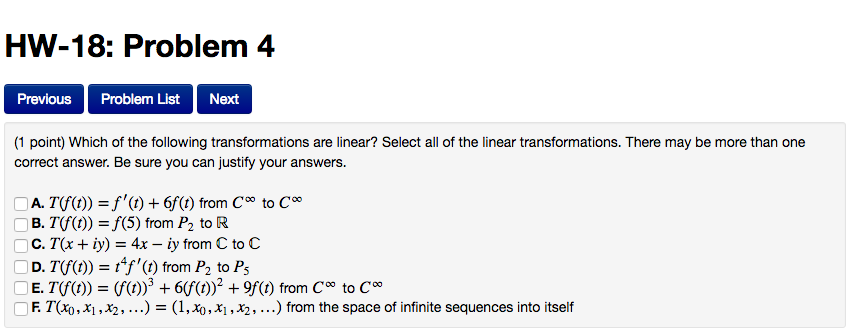Which Of The Following Transformations Are Linear. Which of the following transformations are linear? Advanced math questions and answers.

T (f (t)) = [ f (t)dt from p, to r b.t (f (t)) = f (4) from p2 to r c.t (f (t)) = (f (t))3 + 9 (f (t))2 +8f (t) from cº to cº d.t. The transformation t defined by t(x1,x2)=(4x1−2x2,3|x2|) e. U !v is a linear transformation between nite dimensional vector spaces then null(l) + rank(l) = dim(u).
Theorem Suppose U And V Are Nite Dimensional Vector Spaces A Linear Transformation L :
In this problem we have been given to linear transformations. Such a line is a function of the type $$f:\bbb r\to \bbb r \\ f(x) = ax+b$$ where $b\ne 0$. There may be more than one correct answer.
There May Be More Than One Correct Answer.
The product of the matrix times victor. Two examples of linear transformations (1) diagonal matrices: 10х — 6у + 9:1 а.
Advanced Math Questions And Answers.
Y_1 = 9x_1 and y_2 = 5 d. Which of the following transformations are linear? Transformations in the change of basis formulas are linear, and most geometric operations, including rotations, reflections, and contractions/dilations, are linear transformations.
Which Of The Following Transformations Are Linear?
For 2 just consider the polynomial p 1 ( x) = p 2 ( x) = x you can easily check that t ( p 1 ( x) + p 2 ( x)) ≠ t ( p 1 ( x)) + t ( p 2 ( x)) share answered mar 1 '18 at 7:07 the_firehawk 2,212 1 11 30 add a. Which of the following transformations are linear? Solution for which of the following transformations are linear?
U !V Is Invertible If And Only If Rank(L) = Dim(V) And Null(L) = 0.
P2 is the vector space consisting of all polynomials of degree 2 and p3 of degree 3. One of the easy route plus e. There may be more than one correct answer.